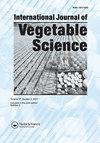Evaluation of nitrate accumulation, bioactive compounds and antioxidant activity in leaves of radish cultivars
IF 1.1
Q2 Agricultural and Biological Sciences
引用次数: 0
Abstract
ABSTRACTIdentifying, and evaluating, the nutritional and toxic compounds in radish (Raphanus sativus L.) is important for breeding. This study investigates the quality and health indices in leaves of radish cultivars: Cherry Belle, Champion, French Breakfast, Sparkler, and a local landrace (Isfahan). Difference were observed in contents of dry matter (7.84–11.23%) and ash (1.12–2.05%) in leaves of radish cultivars. Nitrate content in leaves 1780–5234 mg·kg−1 which was 71.2–209.3% of the permissible limit. “Cherry Belle” and the local cultivar had the highest nitrate content. With increased dry matter accumulation in leaves, nitrate content decreased. Cultivars that have a higher photosynthesis capacity, represent more capability in nitrate consumption. The IC50 in leaves was 33.1%. The local landrace had the highest antioxidant capacity and “Cherry Belle” the lowest. The phenolic content and vitamin C in leaves of radish cultivars was 99.9 mg GAE/100 g and 34.25 mg/100 g, respectively. Radish leaves were rich in vitamin C. It is apparently possible to develop cultivars that have higher content of bioactive compounds and lower nitrate accumulation.KEYWORDS: Raphanus sativusash contentdry matter contentphenolic compoundsvitamin C Disclosure statementNo potential conflict of interest was reported by the author(s).萝卜品种叶片硝酸盐积累、生物活性化合物及抗氧化活性的评价
摘要鉴别和评价萝卜(Raphanus sativus L.)中的营养和有毒成分对育种具有重要意义。本研究对樱桃百丽、冠军、法式早餐、斯巴克勒和一个地方地方品种(伊斯法罕)萝卜叶片的品质和健康指标进行了研究。不同品种萝卜叶片干物质含量(7.84 ~ 11.23%)和灰分含量(1.12 ~ 2.05%)存在差异。叶片硝酸盐含量为1780 ~ 5234 mg·kg−1,为允许限量的71.2 ~ 209.3%。“樱桃百丽”和本地品种的硝酸盐含量最高。随着叶片干物质积累量的增加,硝酸盐含量降低。光合作用能力越强的品种,对硝酸盐的消耗能力越强。叶片IC50为33.1%。地方长白抗氧化能力最高,樱桃百丽抗氧化能力最低。萝卜品种叶片中酚类物质含量为99.9 mg GAE/100 g,维生素C含量为34.25 mg/100 g。萝卜叶含有丰富的维生素c,显然有可能培育出具有较高生物活性化合物含量和较低硝酸盐积累的品种。关键词:萝卜含量、物质含量、酚类化合物、维生素C披露声明作者未报告潜在利益冲突。
本文章由计算机程序翻译,如有差异,请以英文原文为准。
求助全文
约1分钟内获得全文
求助全文
来源期刊

International Journal of Vegetable Science
Agricultural and Biological Sciences-Plant Science
CiteScore
3.10
自引率
0.00%
发文量
30
期刊介绍:
The International Journal of Vegetable Science features innovative articles on all aspects of vegetable production, including growth regulation, pest management, sustainable production, harvesting, handling, storage, shipping, and final consumption. Researchers, practitioners, and academics present current findings on new crops and protected culture as well as traditional crops, examine marketing trends in the commercial vegetable industry, and address vital issues of concern to breeders, production managers, and processors working in all continents where vegetables are grown.
 求助内容:
求助内容: 应助结果提醒方式:
应助结果提醒方式:


